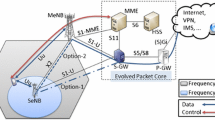Abstract
The general trend in the backhaul link technology arena is the increasing use of high-speed microwave solutions. The ever-rising demand for high capacities at low cost has recently enhanced the interest in wireless backhaul networks. Evaluating the connectivity of the wireless multi-hop backhaul networks is a significant task. Taking into account the high frequency of operation, a novel analytical and engineering propagation model is presented for the calculation of connectivity. Furthermore, the minimum required node density in order to keep the network connected is also calculated. The sensitivity of network connectivity on frequency operation, transmission power, and climatic conditions is also investigated. Finally, the error performance of the backhaul network links is finally presented, and some very useful conclusions are drawn.








Similar content being viewed by others
References
Ericsson (2008) High-speed technologies for mobile backhaul. White paper. http://www.ericsson.com/technology/whitepapers/broadband/high-speed_mobile_backhaul.shtml
Ericsson AB (2008) Mobile broadband backhaul: addressing the challenge. Ericsson review no. 3
Little S (2009) Is microwave backhaul up to 4 G task? IEEE Microw Mag 10:67–74
Lockie D, Peck D (2009) High-data-rate millimeter-wave radios. IEEE Microw Mag 10:75–83
ITU-R (2007) Propagation data and prediction methods required for the design of terrestrial broadband radio access systems operating in a frequency range from 3 to 60 GHz. ITU-R Recommendation P.1410-4, Geneva
FCC (2005) Allocations and service rules for 71–76 GHz, 81–86 GHz and 92–95 GHz bands. http://wireless.fcc.gov/index?job=rules_and_regulations
Davis CC, Smolyaninov II, Milner SD (2003) Flexible optical wireless links and networks. IEEE Commun Mag 41:51–57
Arnon S (2003) Optimization of urban optical wireless communication systems. IEEE Trans Wireless Comm 2:626–629
Crane RK (1996) Electromagnetic wave propagation through rain. Wiley, New York
Fong B, Hong GY, Fong ACM (2002) A modulation scheme for broadband wireless access in high capacity networks. IEEE Trans Consum Electron 48(3):457–462
Fong B, Rapajic PB, Hong GY, Fong ACM (2003) Forward error correction with Reed–Solomon codes for wearable computers. IEEE Trans Consum Electron 49(4):917–921
Drougas AE, Panagopoulos AD, Cottis PG (2007) Data transmission over rain-faded broadband fixed wireless access channels. IEEE Trans Consum Electron 53(3):871–876
Panagopoulos AD, Kanellopoulos JD (2003) Statistics of differential rain attenuation on converging terrestrial propagation paths. IEEE Trans Antennas Propag 51(9):2514–2517
Panagopoulos AD, Kanellopoulos JD (2003) Differential rain attenuation statistics on two converging point-to-point terrestrial links located in a tropical climatic region. Annals on Telecommunications 58(3–4):673–667
Cheffena M, Braten L, Ekman T (2009) On the space–time variations of rain attenuation. IEEE Trans Antennas Propag 57(6):1771–1782
Erdos P, Renyi A (1960) On the evolution of random graphs. Publ Math Inst Hungar Acad Sci 5:17–61
Bollobas B (1998) Modern graph theory. Springer, Heidelberg
Panagopoulos AD, Arapoglou PD, Kanellopoulos J, Cottis P (2005) Long-term rain attenuation probability and site diversity gain prediction formulas. IEEE Trans Antennas Propag 53(7):2307–2313
ITU-R (2007) Characteristics of precipitation for propagation modeling. ITU-R Recommendation P. 837-5, Geneva
ITU-R (2005) Specific attenuation model for rain for use in prediction methods. ITU-R Recommendation P. 838-3, Geneva
Bettstetter C, Hartmann C (2005) Connectivity of wireless multihop networks in a shadow fading environment. Wirel Netw 11:571–579
Abramovitz M, Stegun I (1965) Handbook of mathematical functions. Dover, New York
Miorandi D et al (2008) The impact of channel randomness on coverage and connectivity of Ad Hoc and sensor networks. IEEE Trans On Wir Commun 7(3):1062–1072
Goldsmith A (2005) Wireless communications. Stanford University, Stanford
Author information
Authors and Affiliations
Corresponding author
Rights and permissions
About this article
Cite this article
Pitsiladis, G.T., Panagopoulos, A.D. & Constantinou, P. Connectivity evaluation and error performance of millimeter-wave wireless backhaul networks. Ann. Telecommun. 65, 795–802 (2010). https://doi.org/10.1007/s12243-010-0185-z
Received:
Accepted:
Published:
Issue Date:
DOI: https://doi.org/10.1007/s12243-010-0185-z




